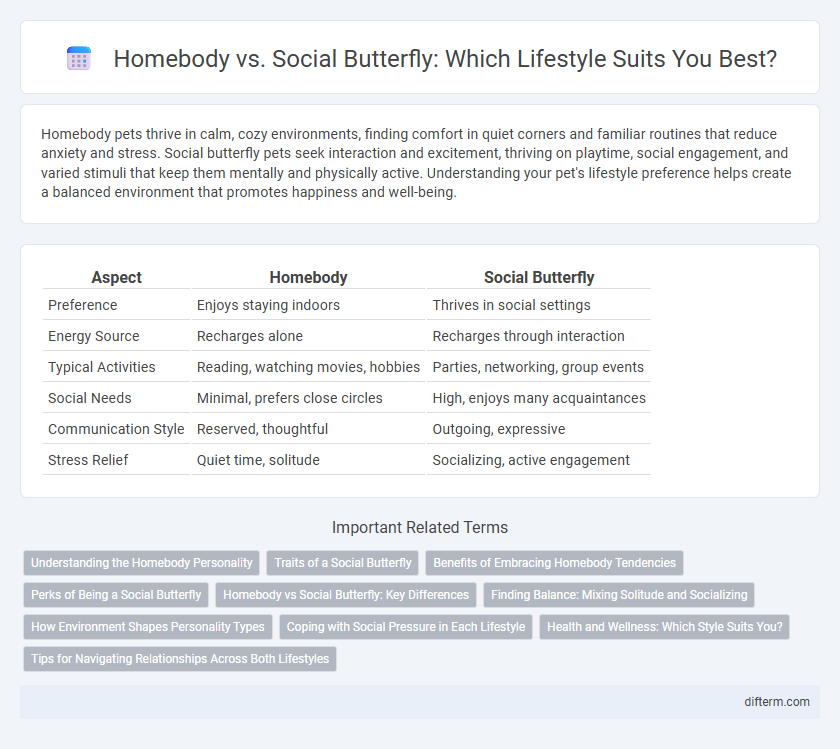Homebody pets thrive in calm, cozy environments, finding comfort in quiet corners and familiar routines that reduce anxiety and stress. Social butterfly pets seek interaction and excitement, thriving on playtime, social engagement, and varied stimuli that keep them mentally and physically active. Understanding your pet's lifestyle preference helps create a balanced environment that promotes happiness and well-being.
Table of Comparison
| Aspect | Homebody | Social Butterfly |
|---|---|---|
| Preference | Enjoys staying indoors | Thrives in social settings |
| Energy Source | Recharges alone | Recharges through interaction |
| Typical Activities | Reading, watching movies, hobbies | Parties, networking, group events |
| Social Needs | Minimal, prefers close circles | High, enjoys many acquaintances |
| Communication Style | Reserved, thoughtful | Outgoing, expressive |
| Stress Relief | Quiet time, solitude | Socializing, active engagement |
Understanding the Homebody Personality
Homebody personalities prioritize comfort, solitude, and familiar environments, often finding energy and relaxation in quiet, personal spaces. They tend to engage in introspective hobbies such as reading, cooking, or creative arts, which cultivate inner balance and emotional well-being. Understanding homebodies involves recognizing their need for minimal social stimuli and appreciating their preference for meaningful, small-scale interactions over large social gatherings.
Traits of a Social Butterfly
Social butterflies are characterized by their extroverted nature, high energy levels, and strong communication skills, thriving in social environments where they easily build connections. They possess an innate ability to engage diverse groups, making them popular in gatherings and networking events. This outgoing personality often leads to extensive social networks and a rich tapestry of interpersonal experiences.
Benefits of Embracing Homebody Tendencies
Embracing homebody tendencies promotes mental well-being through reduced social stress and increased opportunities for self-reflection and creativity. Creating a personalized sanctuary at home enhances comfort and productivity, fostering a balanced lifestyle. Prioritizing quiet, solitary activities supports deeper relaxation and improves overall emotional resilience.
Perks of Being a Social Butterfly
Social butterflies thrive on frequent social interactions, which enhance their networking opportunities and foster emotional well-being through diverse connections. Engaging actively in social events boosts their communication skills and increases access to career and personal growth opportunities. Their dynamic social life often leads to a broader support system and enriched experiences that contribute to higher overall life satisfaction.
Homebody vs Social Butterfly: Key Differences
Homebodies prefer the comfort and tranquility of their own space, often engaging in solitary activities like reading, cooking, or watching movies, which helps them recharge and reduce stress. Social butterflies thrive on interaction, seeking out gatherings, parties, and group activities to boost their energy and maintain emotional well-being. Key differences lie in energy sources--introverted solitude for homebodies versus extroverted social stimulation for social butterflies--impacting lifestyle choices, mental health, and daily routines.
Finding Balance: Mixing Solitude and Socializing
Balancing solitude and socializing enhances mental well-being by blending the tranquility of being a homebody with the stimulation enjoyed by social butterflies. Incorporating periods of introspection and quiet recharge alongside engaging social activities fosters emotional resilience and personal growth. This equilibrium supports a lifestyle where both inner peace and external connections thrive harmoniously.
How Environment Shapes Personality Types
Homebody personalities often develop in calm, organized environments that promote introspection and comfort, fostering traits like thoughtfulness and self-sufficiency. Social butterflies thrive in dynamic, stimulating settings rich with social interaction, which enhances their extroversion and adaptability. Environmental factors such as noise levels, space design, and community culture play crucial roles in shaping whether individuals prefer solitude or sociability.
Coping with Social Pressure in Each Lifestyle
Homebodies cope with social pressure by creating structured routines and finding solace in solitary activities like reading or gardening, which reduce anxiety and foster mental well-being. Social butterflies manage pressure through frequent social interactions and diverse support networks, often using group activities to boost confidence and alleviate stress. Both lifestyles benefit from setting personal boundaries to maintain balance and preserve emotional health amid external expectations.
Health and Wellness: Which Style Suits You?
Homebodies often benefit from reduced stress levels and improved mental clarity due to their preference for quiet, controlled environments that promote relaxation and restorative routines. Social butterflies enhance their emotional health through frequent social interactions, which boost oxytocin levels and foster a sense of belonging and happiness. Evaluating personal energy levels and mental health needs helps determine whether solitude or social engagement best supports overall wellness.
Tips for Navigating Relationships Across Both Lifestyles
Understanding the distinct needs of homebodies and social butterflies helps foster healthier relationships by respecting personal boundaries and social preferences. Effective communication involves setting clear expectations about alone time and social engagement, ensuring both parties feel valued and understood. Balancing quality quiet moments with occasional social activities can strengthen connections while honoring individual lifestyle choices.
homebody vs social butterfly Infographic

 difterm.com
difterm.com